47 UMMA Objects
47 UMMA Objects

Artist Unknown, Gandhara (Ancient Pakistan and Afghanistan)
Turbaned head of a male figure, Hadda type (Afghanistan)
200 – 499
Museum purchase for the James Marshall Plumer Memorial Collection
1961/2.84
![It has a outward-turned rim. The side of the body is becoming narrow in the base. The bottem is flat.<br />
<br />
This yellowish brown, bowl-shaped, low-fired earthenware vessel is made from fine clay mixed with fine sand particles. It has no neck. The mouth is slightly everted while the rim is generally flat and features some grooves. The body is widest towards the upper-middle section, and the flat base is rounded where it joins the body. Parts of the vessel feature a paddled pattern which suggests that the surface was first paddled and then smoothed with water on a rotary device.<br />
[Korean Collection, University of Michigan Museum of Art (2017) p. 44]<br />
It has a outward-turned rim. The side of the body is becoming narrow in the base. The bottem is flat.<br />
<br />
This yellowish brown, bowl-shaped, low-fired earthenware vessel is made from fine clay mixed with fine sand particles. It has no neck. The mouth is slightly everted while the rim is generally flat and features some grooves. The body is widest towards the upper-middle section, and the flat base is rounded where it joins the body. Parts of the vessel feature a paddled pattern which suggests that the surface was first paddled and then smoothed with water on a rotary device.<br />
[Korean Collection, University of Michigan Museum of Art (2017) p. 44]<br />
](/media/W1siZiIsIjIwMjIvMDkvMjQvNjVoNTM5eGtxal9kZWZhdWx0LmpwZyJdLFsicCIsInRodW1iIiwiMjQweDIwMCJdXQ?sha=d9e7c69efc7a919f)
Korean (Korean (culture or style))
Bowl with flat bottom and flat rolled rim
300 – 499
Gift of Bruce and Inta Hasenkamp and Museum purchase made possible by Elder and Mrs. Sang-Yong Nam
2004/1.160
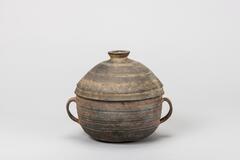
Korean (Korean (culture or style))
Two-handled bowl with cover
400 – 599
Gift of Bruce and Inta Hasenkamp and Museum purchase made possible by Elder and Mrs. Sang-Yong Nam
2004/1.182A&B
![It has a flat base, globular body and straight neck. There was a bubbling of the clay surface during firing. The attached handle is a little small and thick.<br />
<br />
This is a yellowish gray, low-fired earthenware cup with a handle. The mouth is upright, while the rest of the body has a swollen belly and a round base. The handle attached to the lower middle section of the body is not functional. Traces of rotation and water smoothing are visible on the inner and outer surfaces of the mouth.
<p>[Korean Collection, University of Michigan Museum of Art (2017) p. 68]</p>
<br />
It has a flat base, globular body and straight neck. There was a bubbling of the clay surface during firing. The attached handle is a little small and thick.<br />
<br />
This is a yellowish gray, low-fired earthenware cup with a handle. The mouth is upright, while the rest of the body has a swollen belly and a round base. The handle attached to the lower middle section of the body is not functional. Traces of rotation and water smoothing are visible on the inner and outer surfaces of the mouth.
<p>[Korean Collection, University of Michigan Museum of Art (2017) p. 68]</p>
<br />
](/media/W1siZiIsIjIwMjIvMDkvMjQvMWQybmE1M3FtYl9kZWZhdWx0LmpwZyJdLFsicCIsInRodW1iIiwiMjQweDIwMCJdXQ?sha=618fba87ddd6f364)
Korean (Korean (culture or style))
Small Single-Handed Cup
5th century
Gift of Bruce and Inta Hasenkamp and Museum purchase made possible by Elder and Mrs. Sang-Yong Nam
2004/1.190
![This bright grayish-blue stoneware jar consists of a round base, globular body and long flaring neck. Narrow single ridges encircle the middle part of the neck, dividing it into four sections. Each section is engraved with a wave pattern. The shoulder doesn’t have any pattern.<br />
<br />
This is a blue-gray, long-necked, high-fired stoneware jar. The horizontal ridge on the upper part of the long vessel neck marks the boundary between the neck and its inwardly curved mouth. The mouth slopes inward and has a sharp edge. The neck is divided into four sections by three horizontal ridges spaced at equal intervals, and each section is decorated by a wave design rendered with a comb with approximately ten teeth. The jar is widest at its upper-middle part, and the base is round with a slightly recessed center.<br />
[Korean Collection, University of Michigan Museum of Art (2017) p. 47]<br />
This bright grayish-blue stoneware jar consists of a round base, globular body and long flaring neck. Narrow single ridges encircle the middle part of the neck, dividing it into four sections. Each section is engraved with a wave pattern. The shoulder doesn’t have any pattern.<br />
<br />
This is a blue-gray, long-necked, high-fired stoneware jar. The horizontal ridge on the upper part of the long vessel neck marks the boundary between the neck and its inwardly curved mouth. The mouth slopes inward and has a sharp edge. The neck is divided into four sections by three horizontal ridges spaced at equal intervals, and each section is decorated by a wave design rendered with a comb with approximately ten teeth. The jar is widest at its upper-middle part, and the base is round with a slightly recessed center.<br />
[Korean Collection, University of Michigan Museum of Art (2017) p. 47]<br />
](/media/W1siZiIsIjIwMjIvMDkvMjQvM2M4cmF2ZmJ5OV9kZWZhdWx0LmpwZyJdLFsicCIsInRodW1iIiwiMjQweDIwMCJdXQ?sha=62bb2075b9e5bebe)
Korean (Korean (culture or style))
Storage jar with bands of incised wavy patterns at neck; lid missing
5th century
Museum purchase made possible by the Margaret Watson Parker Art Collection Fund
2003/1.384
![It has a flat base, globular body and straight neck with an everted rim. The color is dark grayish-blue.<br />
<br />
This is a blue-gray, high-fired stoneware cup with a handle. The mouth of the cup is slightly splayed and has a narrow, rounded rim. The body is widest at its center where a semicircular handle is attached vertically. The inner and outer surfaces show faint traces of rotation and water smoothing. The base is wide and flat and has no foot.
<p>[Korean Collection, University of Michigan Museum of Art (2017) p. 70]</p>
It has a flat base, globular body and straight neck with an everted rim. The color is dark grayish-blue.<br />
<br />
This is a blue-gray, high-fired stoneware cup with a handle. The mouth of the cup is slightly splayed and has a narrow, rounded rim. The body is widest at its center where a semicircular handle is attached vertically. The inner and outer surfaces show faint traces of rotation and water smoothing. The base is wide and flat and has no foot.
<p>[Korean Collection, University of Michigan Museum of Art (2017) p. 70]</p>](/media/W1siZiIsIjIwMjIvMDUvMjUvNGV2em85OThkdF9kZWZhdWx0LmpwZyJdLFsicCIsInRodW1iIiwiMjQweDIwMCJdXQ?sha=2d2a81114b915f5e)
Korean (Korean (culture or style))
Cup with small handle
400 – 599
Gift of Toshiko Ogita in memory of Tomoo Ogita
1987/1.310
![It looks like a rescent, animal's tooth or fetus. There is a hole and some carved line on the head part.<br />
<br />
This is a comma-shaped bead made from dark green jade. Such crescent moon-shaped beads, referred to as<em> gogok</em>, were used to decorate golden crowns, clothing, and belts. This example, which was attached to other ornaments via the hole in its head, is typical of comma-shaped beads of the Three Kingdoms period. Three parallel lines are incised across the hole, from which four more incised lines radiate upwards.<br />
[Korean Collection, University of Michigan Museum of Art (2017) p.33] It looks like a rescent, animal's tooth or fetus. There is a hole and some carved line on the head part.<br />
<br />
This is a comma-shaped bead made from dark green jade. Such crescent moon-shaped beads, referred to as<em> gogok</em>, were used to decorate golden crowns, clothing, and belts. This example, which was attached to other ornaments via the hole in its head, is typical of comma-shaped beads of the Three Kingdoms period. Three parallel lines are incised across the hole, from which four more incised lines radiate upwards.<br />
[Korean Collection, University of Michigan Museum of Art (2017) p.33]](/media/W1siZiIsIjIwMjIvMDUvMjUvNXUwNHN1cTN0Y19kZWZhdWx0LmpwZyJdLFsicCIsInRodW1iIiwiMjQweDIwMCJdXQ?sha=70118906356121f7)
Korean (Korean (culture or style))
Comma-shaped Pendant
400 – 599
Museum purchase made possible by the Margaret Watson Parker Art Collection Fund
1983/1.152
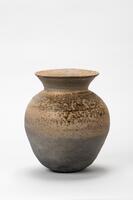
Korean (Korean (culture or style))
Cord-marked round-bottomed jar with wide, flared mouth
5th century
Gift of Bruce and Inta Hasenkamp and Museum purchase made possible by Elder and Mrs. Sang-Yong Nam
2004/1.166
![Flared base with rounded food storage bowl on top. The base is cut with evenly spaced rectangular holes. The lid is incised with a repeating herringbone, or dotted design. The know on the lid is the shape of a Buddhist canopy, or chattra.<br />
<br />
This is a dark blue-gray, high-fired stoneware lidded stem cup. The lid is crowned by a pearl-shaped knob, while both the inner and outer surfaces of lid have traces related to the attachment of the knob to the lid. A v-shaped pattern of engraved dots, made using a sixtooth comb, surrounds the central knob. The cup’s flange slopes inwards and has a sharp edge. The cup body has a horizontal gallery that holds the lid in place. The stem is perforated by rectangular openings, below which is a sharply protruding circular raised band. Traces of rotation and water smoothing are visible on the body and stem of the cup.
<p>[Korean Collection, University of Michigan Museum of Art (2017) p. 59]</p>
Flared base with rounded food storage bowl on top. The base is cut with evenly spaced rectangular holes. The lid is incised with a repeating herringbone, or dotted design. The know on the lid is the shape of a Buddhist canopy, or chattra.<br />
<br />
This is a dark blue-gray, high-fired stoneware lidded stem cup. The lid is crowned by a pearl-shaped knob, while both the inner and outer surfaces of lid have traces related to the attachment of the knob to the lid. A v-shaped pattern of engraved dots, made using a sixtooth comb, surrounds the central knob. The cup’s flange slopes inwards and has a sharp edge. The cup body has a horizontal gallery that holds the lid in place. The stem is perforated by rectangular openings, below which is a sharply protruding circular raised band. Traces of rotation and water smoothing are visible on the body and stem of the cup.
<p>[Korean Collection, University of Michigan Museum of Art (2017) p. 59]</p>](/media/W1siZiIsIjIwMjIvMDkvMjQvOTRoajlpcWRqbV9kZWZhdWx0LmpwZyJdLFsicCIsInRodW1iIiwiMjQweDIwMCJdXQ?sha=27b6314c0d4219a2)
Korean (Korean (culture or style))
Pedestal Bowl with Cover
5th century
Gift of Bruce and Inta Hasenkamp and Museum purchase made possible by Elder and Mrs. Sang-Yong Nam
2004/1.169A&B
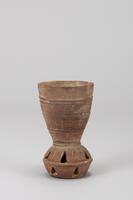
Korean (Korean (culture or style))
Bell Cup (goblet with rattle base)
5th century
Gift of Bruce and Inta Hasenkamp and Museum purchase made possible by Elder and Mrs. Sang-Yong Nam
2004/1.170
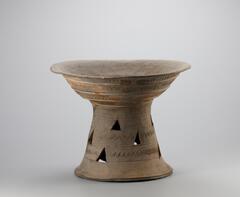
Korean (Korean (culture or style))
Large bowl or stand on high cut-out pedestal foot
5th century
Gift of Bruce and Inta Hasenkamp and Museum purchase made possible by Elder and Mrs. Sang-Yong Nam
2004/1.177
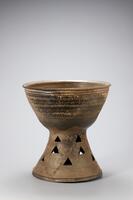
Korean (Korean (culture or style))
Large Pedestal Bowl or Stand
5th century
Gift of Bruce and Inta Hasenkamp and Museum purchase made possible by Elder and Mrs. Sang-Yong Nam
2004/1.179
Loading…
